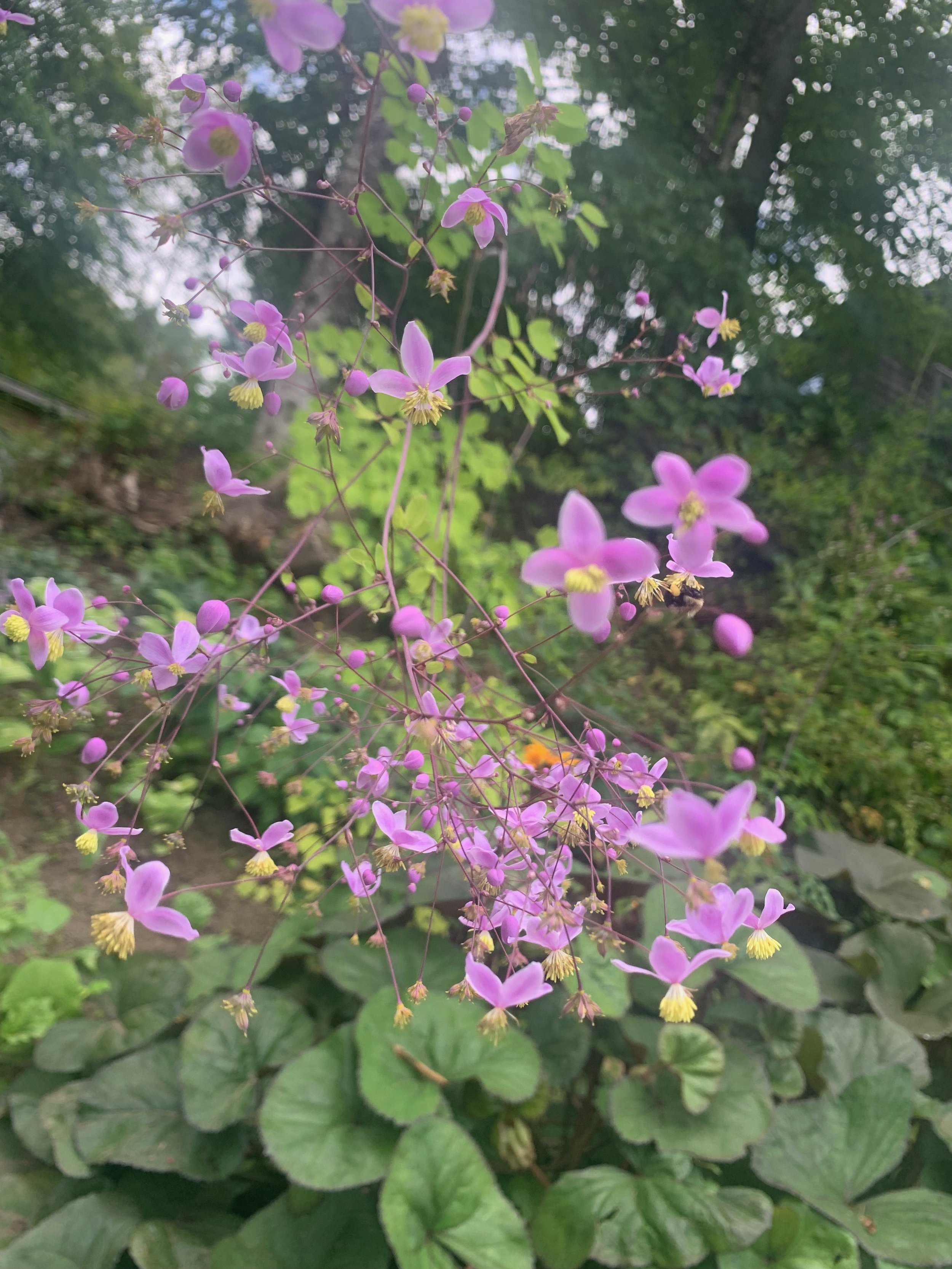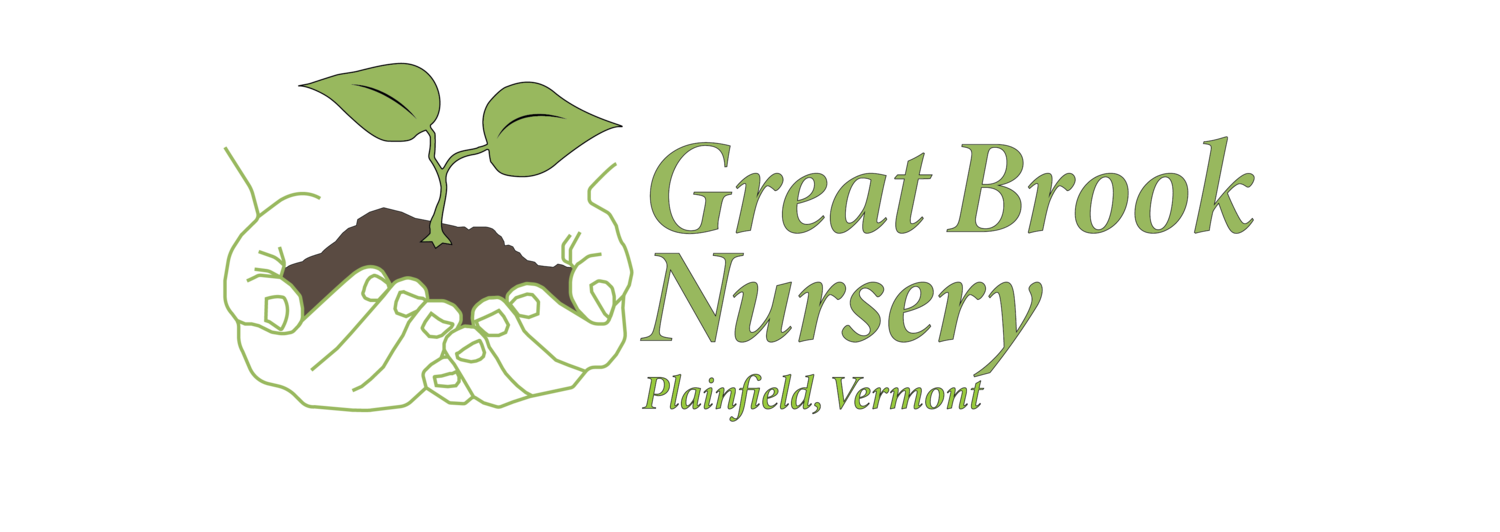 Image 1 of
Image 1 of


Thalictrum (Ranunculaceae)
Commonly called Meadow Rue for the leaves that resemble the European rue, our native thalictrum grows in dappled shade in damp locations and puts up a tuft of white flowers in the early summer and leaves a nice plant that remains stately and green for the rest of the season. The generally erect stem has pinnate leaves with lobed leaflets. It produces clusters, sometimes large of tiny petalless flowers with contrasting stamens and pistils that often persist over a long period. Flowers range from white to light yellow and in shades of pinks and purples. A few years ago I was introduced to some of the cultivars and native Asian species and there are some beautiful and garden worthy plants out there. The variety of forms of this species is broad. From graceful, 7 ft giants that sometimes need staking to creeping ground covers that grow only 4” tall. We have been propagating several species and cultivars. Though it is often referenced as a shade plant, we have found that with cool, evenly moist soil it seems just fine with morning to early afternoon sun and seem to stay more upright. Likes a rich soil.
AVAILABLE THIS YEAR
T. adiantifolium var. minus - A small form from 1’-2’ with greenish-yellow flowers in mid summer. The delicate ferny foliage persists all summer.
T. delavayi ‘Album’ - Similar to our native, but fuller. Grows 3’-5’. Flowers July and August. A white form of the Chinese meadow rue.
T. kiusianum - A tiny mat-forming species that spreads like a delicate ground cover. In early summer, tiny tufts of purple flowers float above the foliage. Flowers over a long period. Choice!
T. rochebruneanum - A tall, upright form to 6’. Flowers late summer with purple sepals and yellow stamens over a long period. Sometimes needs staking. Though tall and full, its wispy form never obscures things behind it.
Sold in quarts. T. rochebruneanum sold in 300’s.
Commonly called Meadow Rue for the leaves that resemble the European rue, our native thalictrum grows in dappled shade in damp locations and puts up a tuft of white flowers in the early summer and leaves a nice plant that remains stately and green for the rest of the season. The generally erect stem has pinnate leaves with lobed leaflets. It produces clusters, sometimes large of tiny petalless flowers with contrasting stamens and pistils that often persist over a long period. Flowers range from white to light yellow and in shades of pinks and purples. A few years ago I was introduced to some of the cultivars and native Asian species and there are some beautiful and garden worthy plants out there. The variety of forms of this species is broad. From graceful, 7 ft giants that sometimes need staking to creeping ground covers that grow only 4” tall. We have been propagating several species and cultivars. Though it is often referenced as a shade plant, we have found that with cool, evenly moist soil it seems just fine with morning to early afternoon sun and seem to stay more upright. Likes a rich soil.
AVAILABLE THIS YEAR
T. adiantifolium var. minus - A small form from 1’-2’ with greenish-yellow flowers in mid summer. The delicate ferny foliage persists all summer.
T. delavayi ‘Album’ - Similar to our native, but fuller. Grows 3’-5’. Flowers July and August. A white form of the Chinese meadow rue.
T. kiusianum - A tiny mat-forming species that spreads like a delicate ground cover. In early summer, tiny tufts of purple flowers float above the foliage. Flowers over a long period. Choice!
T. rochebruneanum - A tall, upright form to 6’. Flowers late summer with purple sepals and yellow stamens over a long period. Sometimes needs staking. Though tall and full, its wispy form never obscures things behind it.
Sold in quarts. T. rochebruneanum sold in 300’s.
Commonly called Meadow Rue for the leaves that resemble the European rue, our native thalictrum grows in dappled shade in damp locations and puts up a tuft of white flowers in the early summer and leaves a nice plant that remains stately and green for the rest of the season. The generally erect stem has pinnate leaves with lobed leaflets. It produces clusters, sometimes large of tiny petalless flowers with contrasting stamens and pistils that often persist over a long period. Flowers range from white to light yellow and in shades of pinks and purples. A few years ago I was introduced to some of the cultivars and native Asian species and there are some beautiful and garden worthy plants out there. The variety of forms of this species is broad. From graceful, 7 ft giants that sometimes need staking to creeping ground covers that grow only 4” tall. We have been propagating several species and cultivars. Though it is often referenced as a shade plant, we have found that with cool, evenly moist soil it seems just fine with morning to early afternoon sun and seem to stay more upright. Likes a rich soil.
AVAILABLE THIS YEAR
T. adiantifolium var. minus - A small form from 1’-2’ with greenish-yellow flowers in mid summer. The delicate ferny foliage persists all summer.
T. delavayi ‘Album’ - Similar to our native, but fuller. Grows 3’-5’. Flowers July and August. A white form of the Chinese meadow rue.
T. kiusianum - A tiny mat-forming species that spreads like a delicate ground cover. In early summer, tiny tufts of purple flowers float above the foliage. Flowers over a long period. Choice!
T. rochebruneanum - A tall, upright form to 6’. Flowers late summer with purple sepals and yellow stamens over a long period. Sometimes needs staking. Though tall and full, its wispy form never obscures things behind it.
Sold in quarts. T. rochebruneanum sold in 300’s.

